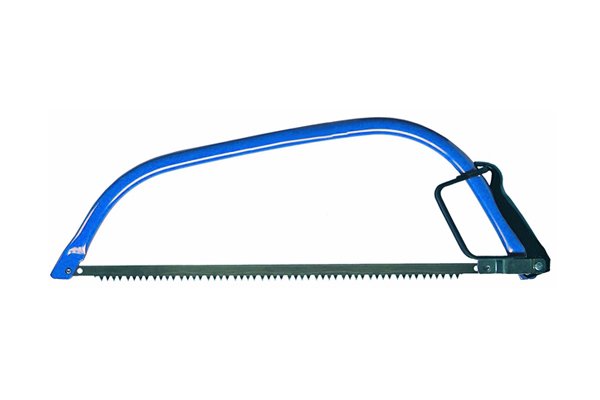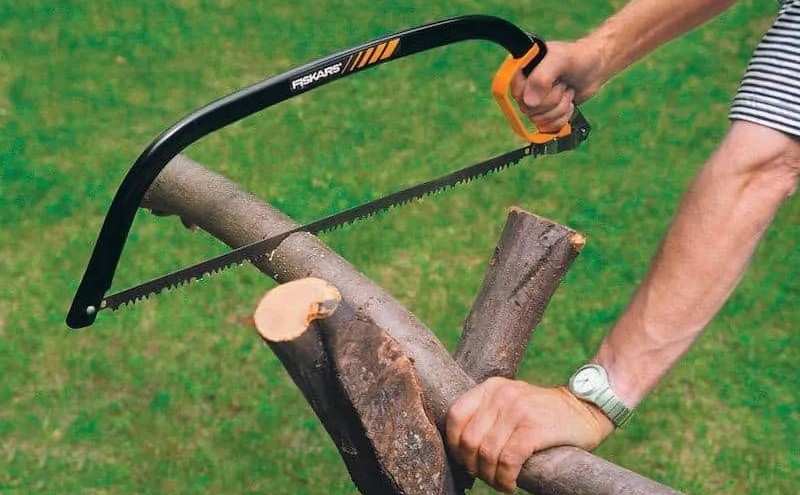A bow saw is a versatile cutting tool. It is known for its U-shaped frame and replaceable blade.
A bow saw is an essential tool for both gardeners and woodworkers. Its design allows for quick and efficient cutting of both green and dry wood. Whether you are pruning trees, cutting firewood, or tackling other DIY projects, a bow saw can be incredibly useful.
The saw’s sharp teeth and tensioned blade make it ideal for a variety of tasks, making your work easier and more efficient. We will explore the many uses of a bow saw and provide tips on how to get the most out of this handy tool. Get ready to discover the full potential of a bow saw!
Introduction To Bow Saws
A bow saw is a handy tool for various cutting tasks. Its unique design makes it suitable for both green and dry wood. Understanding its uses can help you get the most out of this versatile tool.
History And Evolution
The bow saw has a long history. It dates back to ancient times. Early versions were simple but effective. Over centuries, its design improved. Modern bow saws are more efficient and user-friendly.
Initially, bow saws were made of wood. They had a basic blade. As metalworking advanced, blades became stronger. Today, bow saws feature hardened steel blades. These advancements have made cutting easier and faster.
Design And Structure
A bow saw has a unique design. It consists of a metal frame shaped like a bow. This frame holds the blade in place. The tension in the frame keeps the blade tight.
The blade of a bow saw is thin and straight. It has sharp teeth for cutting. Handles on each end of the frame provide a firm grip. These handles help in controlling the saw while cutting.
Some bow saws have adjustable blades. This feature allows for different cutting angles. It adds versatility to the tool.

Credit: www.borrowdaleborrower.com
Primary Uses
A bow saw is used for cutting wood, especially for pruning trees or cutting firewood. It features a long blade with sharp teeth, making it efficient for sawing through branches and logs.
Bow saws are versatile tools that serve many purposes. They are practical for both outdoor and indoor tasks. Here, we will explore their main uses.Cutting Firewood
A bow saw is perfect for cutting firewood. Its sharp teeth make quick work of logs. You can use it to cut branches into smaller pieces. This is useful for campfires or home fireplaces. A bow saw is easy to handle and efficient. It makes preparing firewood a simple task.Pruning Trees And Shrubs
Pruning trees and shrubs is another primary use of a bow saw. It helps maintain the health of your plants. A bow saw can cut through thick branches easily. This makes it ideal for keeping your garden tidy. Regular pruning promotes new growth. It also prevents disease and pest infestation. Using a bow saw makes this job easier and faster. “`Types Of Bow Saws
Understanding the different types of bow saws helps in choosing the right tool for your needs. Bow saws are versatile tools used for cutting wood and other materials. They come in several types, each designed for specific tasks. Below are two common types of bow saws.
Traditional Bow Saws
Traditional bow saws are the most common type. They feature a metal frame shaped like a bow, with a blade stretched between the ends. These saws are ideal for cutting larger pieces of wood. They are often used in woodworking and gardening. The blades can be easily replaced when they become dull. They come in various sizes to suit different tasks.
- Ideal for larger branches and logs
- Sturdy and durable design
- Replaceable blades
- Available in various sizes
Folding Bow Saws
Folding bow saws are portable and convenient. They feature a folding mechanism that makes them easy to carry and store. These saws are perfect for camping and outdoor activities. Despite their compact size, they are strong and efficient. Folding bow saws are designed to handle small to medium-sized woodcutting tasks.
- Portable and easy to store
- Perfect for camping and outdoor use
- Compact yet strong
- Suitable for small to medium tasks
| Type | Best For | Features |
|---|---|---|
| Traditional Bow Saws | Larger branches and logs | Sturdy, various sizes, replaceable blades |
| Folding Bow Saws | Camping and outdoor use | Portable, compact, strong |
Choosing The Right Blade
When selecting a blade for your bow saw, consider several factors. The blade material and tooth pattern play crucial roles. These elements affect the saw’s performance and suitability for different tasks. Below, we’ll explore these factors in detail.
Blade Material
The material of the blade is important for durability and performance. Common materials include:
- Carbon Steel: Known for strength and flexibility. Ideal for heavy-duty work.
- High-Speed Steel (HSS): Resists wear and stays sharp longer. Great for frequent use.
- Bi-Metal: Combines flexibility and toughness. Suitable for various cutting tasks.
Carbon steel blades are cost-effective but may dull faster. HSS blades offer longevity but are pricier. Bi-metal blades balance cost and durability.
Tooth Patterns
The tooth pattern influences the type of cuts your saw can make. Consider the following patterns:
- Raker Teeth: Alternate long and short teeth. Perfect for cutting through green wood.
- Crosscut Teeth: Angled teeth that cut on both push and pull strokes. Ideal for dry wood.
- Peg Teeth: Uniform teeth for general-purpose cutting. Suitable for various materials.
Raker teeth are excellent for fresh wood, providing smooth cuts. Crosscut teeth handle seasoned wood efficiently. Peg teeth offer versatility for different materials.
Choosing the right blade ensures your bow saw performs efficiently. Consider the material and tooth pattern based on your specific needs.
Safety Tips
Using a bow saw can be risky without proper safety measures. Ensuring your safety is crucial for a smooth and accident-free experience. Let’s explore some important safety tips.
Proper Handling
Always hold the bow saw with both hands. This ensures better control and stability. Make sure the blade is sharp to prevent slippage. A dull blade can cause accidents.
Position your body correctly. Stand with your feet shoulder-width apart. This stance offers better balance and reduces the risk of falling. Focus on maintaining a firm grip on the handle. This reduces the chances of losing control.
Use smooth, even strokes. Avoid pushing the saw too hard. Let the saw do the work. Applying too much force can lead to accidents.
Protective Gear
Wearing the right protective gear is essential. It minimizes the risk of injuries. Here are some recommended items:
- Safety glasses: Protects your eyes from wood chips and debris.
- Gloves: Provides a better grip and protects your hands.
- Long sleeves and pants: Shields your skin from scratches and cuts.
- Sturdy boots: Ensures better footing and prevents slips.
Ensure your protective gear fits well. Loose clothing or ill-fitting gear can be dangerous. Regularly check your gear for wear and tear. Replace any damaged items immediately.

Credit: thediyplan.com
Maintenance And Care
Proper maintenance and care of a bow saw ensure its longevity and efficiency. Regular upkeep prevents rust, dullness, and damage. Following simple steps can keep your bow saw in top condition.
Cleaning The Blade
Cleaning the blade after each use is essential. Remove any sap or dirt. Use a wire brush to scrub off stubborn residues. For sticky sap, apply a solvent like mineral spirits.
Once clean, dry the blade completely. Moisture can lead to rust. Consider using a cloth to wipe the blade dry. After drying, lightly coat the blade with machine oil. This helps prevent rust and keeps the blade sharp.
Storing The Saw
Store the bow saw in a dry place. Moisture can cause rust and damage. Hang the saw on a wall or place it in a toolbox. Ensure the blade is not exposed to avoid accidental cuts.
Cover the blade with a blade guard or sheath. This protects the blade from damage and keeps it clean. Avoid storing the saw on the ground or in damp areas.
| Maintenance Task | Frequency |
|---|---|
| Clean the blade | After each use |
| Apply machine oil | After cleaning |
| Store in a dry place | Always |
Following these steps ensures your bow saw remains effective. Proper maintenance saves time and money. A well-cared-for saw makes your work easier and safer.
Advantages Of Using A Bow Saw
Bow saws have been a staple in woodworking and gardening for years. They are known for their efficiency and ease of use. Understanding the advantages of using a bow saw can help you make the most of this tool.
Efficiency And Speed
Bow saws cut through wood quickly and smoothly. Their design allows for fast, clean cuts. This makes them perfect for cutting branches and logs. The sharp blade and tensioned frame ensure every stroke counts. Using a bow saw can save time and effort. You can complete tasks faster compared to other saws.
Portability
Bow saws are lightweight and easy to carry. They are ideal for outdoor tasks. You can take them on camping trips or use them in your backyard. The compact design means they fit easily in your tool shed or car. This portability adds to their versatility. You can use them wherever needed without much hassle.
“`Bow Saw Alternatives
Bow saws are versatile tools for cutting wood. Yet, there are several alternatives available. These alternatives may suit different needs and preferences. Let’s explore some popular options.
Hand Saws
Hand saws are a classic choice for cutting wood. They come in various shapes and sizes. Hand saws are easy to use and maintain. They don’t require power or fuel. This makes them eco-friendly and cost-effective. Hand saws are ideal for smaller projects and fine cuts. They are also safer for beginners.
Chainsaws
Chainsaws are powerful and efficient. They can cut through large logs quickly. Chainsaws are great for heavy-duty tasks and large trees. They come in both electric and gas-powered versions. Chainsaws require more maintenance and safety precautions. They are best suited for experienced users. Chainsaws can save time and effort on big jobs.

Credit: www.wonkeedonkeetools.co.uk
Frequently Asked Questions
What Can You Cut With A Bow Saw?
A bow saw is used to cut wood. It’s great for cutting branches, logs, and firewood.
How Do You Use A Bow Saw Safely?
Use both hands to grip the saw firmly. Cut slowly and steadily to maintain control.
Is A Bow Saw Good For Pruning?
Yes, a bow saw is ideal for pruning large branches. Its sharp teeth make cutting easy.
Can A Bow Saw Cut Metal?
No, a bow saw is not designed for cutting metal. It is best for wood and similar materials.
Conclusion
A bow saw is a versatile tool for many cutting tasks. It works well for pruning trees, cutting firewood, and even DIY projects. Easy to handle, it helps you make quick, clean cuts. Always use it with care to avoid accidents.
Choose the right blade for your needs. A bow saw can be a valuable addition to your toolkit. So, next time you need to cut wood, consider using a bow saw.
